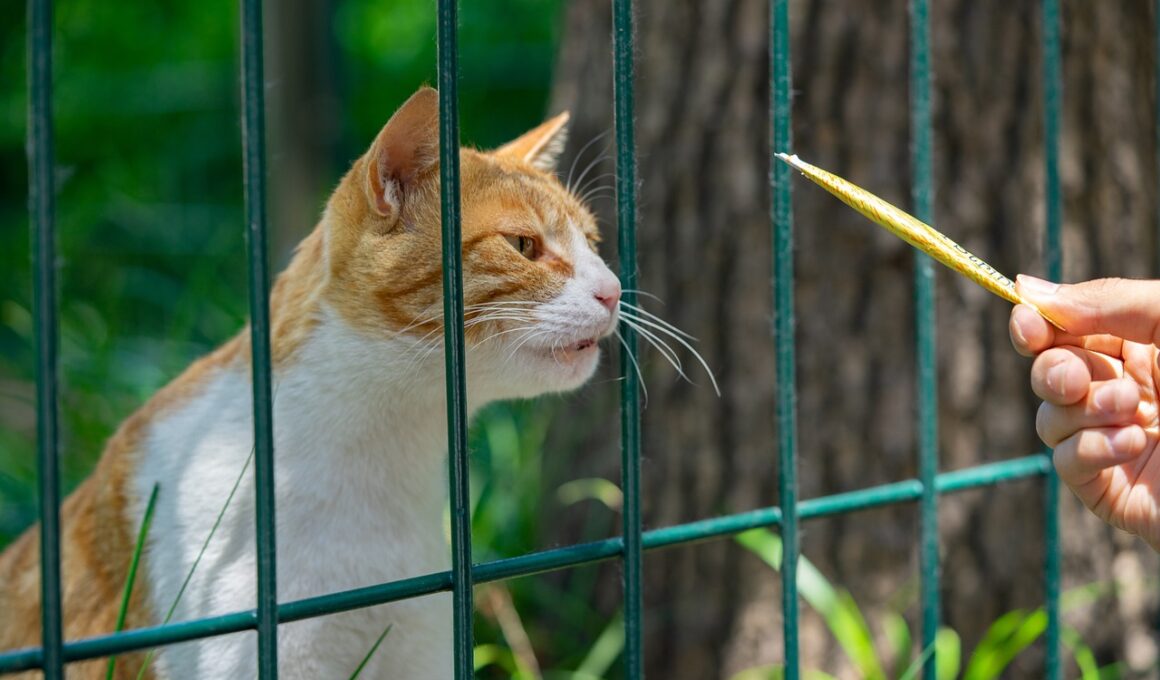How to Use Feeding Strategies to Encourage Unsocial Cats to Socialize
Encouraging unsocial cats to socialize can be a challenging but rewarding experience. One effective method is through strategic feeding. Providing food at scheduled times can create a positive association between humans and a source of comfort. To begin, observe the cat’s behavior. Understanding their triggers can make feeding a successful tool. Start by using safe spaces where the cat feels at ease. Create an area where the food can be placed in a contained, quiet space, away from daily disturbances. This would reduce anxiety and encourage the cat to approach. Gradually introduce your presence by remaining quiet and still. Allow the cat to adjust to your company while they eat. Over time, the cat will start to feel more secure. After several feeding sessions, start speaking softly, gently engaging them in conversation. This helps associate your voice with positive experiences. Additionally, consider leaving multiple feeding stations and scattered food toys to encourage exploration. This not only increases confidence but also promotes curiosity. Emphasizing comfort through these methods not only feeds their bodies but nourishes their social development, paving the way toward a more social feline.
Another effective feeding strategy is the use of puzzle feeders, which stimulate a cat’s mind while they eat. Engage their natural hunting instincts by hiding treats or kibble in these interactive food bowls. The process of seeking food can build confidence over time. As cats work to retrieve their food, they’ll learn to view feeding as a fun activity. Make sure to choose puzzle feeders that are the right difficulty for your particular cat’s skill level to avoid frustration. Start with simpler designs and gradually progress to more engaging ones. This stepwise approach keeps them interested and encourages mental stimulation. Additionally, this not only directs their focus but diverts their natural stress and anxiety, contributing to their overall comfort. To further entice them, try using a variety of high-value treats that encourage consistent participation. You may also incorporate playtime before meals; engage your cat in fun, light activities, and then follow it with feeding. This creates a natural routine that might help in forming positive associations. As trust builds over time, these moments will help transition them closer to social interactions. Engaging unsocial cats through food fosters interactions and contributes to their emotional growth.
Timing is Key
Timing plays a crucial role in utilizing feeding strategies effectively. To enhance socialization efforts, it’s essential to adhere to consistency. Cats generally thrive on routines and may feel more at ease when they anticipate good experiences. Establishing a feeding schedule ensures that your cat knows when food is available. Aim for a fixed feeding time, ideally when the environment is calm and quiet. Limit disturbances during these periods. The cats can learn to associate these predictable moments with positive experiences. Additionally, you can even provide timing-based rewards. When your unsocial cat comes close to you during feeding, reinforce this behavior with gentle praise or light treats. This encourages them to engage more with you over time. Consider using feeding times as an opportunity for gentle interaction. For example, when you place the food down, speak softly to them or offer gentle pets, if they permit it. Over time, this will create a strong association of trust. Ensure that your body language remains relaxed and inviting. When cats sense that you are calm, they may feel more inclined to approach. This consistency fosters a safe environment that promotes socialization.
Another wonderful approach with feeding is the use of slow feeders. These dishes can reduce the speed at which your cat eats, encouraging them to engage longer with their food. Instead of gulping down their meals, slow feeders allow cats to take their time, providing an opportunity to feel at ease in their eating environment. Employing this method can help reduce anxiety, as it promotes a more leisurely pace. Additionally, spend time sitting nearby while your cat uses the slow feeder, emphasizing safety and comfort. Introduce soft music or calming sounds in the background during these moments, as this may help your cat relax even more. Gradually introduce yourself as they eat, reinforcing the idea that you are a benevolent presence. This method allows cats to enjoy their meals while also associating you with a stress-free experience. The combination of slow feeding and your presence can help encourage unsocial cats to feel secure and may provide the incentive necessary to begin socializing. By investing time into these slow feeding moments, you are nurturing trust and supporting their emotional well-being.
Controlled Treat Dispersal
Implementing a controlled treat dispersal method can be highly effective in encouraging unsocial cats to engage with their owners. This strategy is particularly beneficial when seeking to build confidence and establish trust. Use treats that your cat prefers and disperse them in different areas of the home. This technique will encourage them to explore and step out of their comfort zones. Select safe spaces within your living environment, as they may encourage movement. When your cat discovers delicious morsels while investigating, it promotes a sense of adventure and curiosity. Over time, they’ll start anticipating these hidden treats and associate exploration with the expectation of positive outcomes. To enhance the effectiveness of the strategy, you can gradually begin hiding treats closer to your presence, ultimately bringing them within your reach. Pair this practice with soft, encouraging vocalizations to reinforce the idea that you are a source of positive experiences. This approach will ultimately contribute to building their comfort level around you and pave the way toward socialization. Continuous reinforcement through treat dispersal will fuel their motivation to explore various spaces, increasing their preference for interaction over time.
Another valuable feeding strategy to employ is creating a positive feeding environment. This setting can significantly influence your unsocial cat’s willingness to socialize. Choose locations that offer minimal distractions, creating an atmosphere of calmness. Over time, gradually introduce your presence while they eat to allow them to acclimate to your being there. Make your interactions positive by engaging with gentle movements and speaking softly. Once they finish their meals, you can reward them with additional attention and gentle stroking. This reinforces the idea of rewards directly linked to your presence, and the time of feeding becomes a cherished experience. Keep an eye on the cues from your cat; if they seem relaxed, you can slowly build more interaction opportunities over time. Alternatively, if they withdraw, adjust your approach and give them space. Always respect their comfort levels. Small changes in your behavior and routine can instill trust. By adjusting the ambiance surrounding eating, you not only create a safe dining experience, but also build an environment that encourages deeper interactions and eventually leads to increased socialization.
Patience is Essential
The foundation of successfully using feeding strategies for unsocial cats rests on patience. Building trust and socialization is often a gradual process. Each cat has its own unique timeline, which can be influenced by their past experiences and inherent personalities. Recognize that the journey toward encouraging your unsocial cat to engage with you may take time. It is essential to avoid pushing them into interactions before they are ready. Instead, observe their behavior and adjust your strategies accordingly. Celebrate the small victories, such as coming closer to you during feeding or showing curiosity in your presence. Make sure you do not rush the process, as this approach can create feelings of stress or anxiety. Through gentle encouragement and consistent feeding practices, you are laying the groundwork for future interactions. As you foster their trust, the relationships between you and your cat can strengthen. Remember, consistency, love, and understanding will be instrumental in helping them feel secure enough to embrace the world outside their comfort zone. By embodying patience, you will ultimately pave the way for a more sociable feline friend.
Finally, always keep in mind the importance of respecting boundaries. As you work with unsocial cats, it is vital to honor their comfort zone while attempting any feeding strategy to encourage socialization. This concept includes monitoring body language, like ears back or a twitching tail. These signals indicate stress, and responding to them will foster trust. If your cat seems anxious during feeding times, return to earlier strategies that encouraged a feeling of safety. Gradually reintroduce socialization techniques and feeding interactions. Ensure that the environment remains conducive to comfort, filled with positive experiences and reassuring sounds. Seek to create a haven that fosters a sense of security, encouraging gradual engagement as cats adapt to your presence. Forming a lasting bond takes time, and your cat’s emotional journey in exploring trust is fundamental. The right feeding strategies can be a catalyst in transforming the relationship you have with your unsocial cat. By employing patience and adaptation, you will encourage them to explore socialization positively. With these combined techniques, the goal of nurturing an unsocial cat towards a more interactive and charming companion can surely be achieved.


